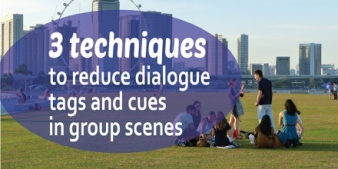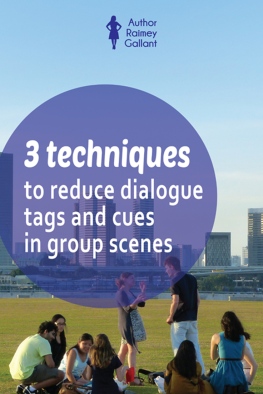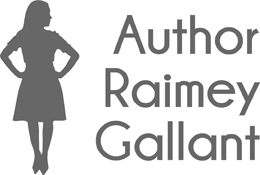
With only two characters, we can get away with less dialogue tags (“You need to brush your teeth,” Kate said) and cues—also referred to as character, emotion, or action beats—(Kate crinkled her nose. “You need to brush your teeth.”), because if we know who’s speaking first, we can intuit that the next pair of quotes encloses dialogue from the only other character in the scene.
But with groups of more than two speakers, scenes can become cluttered with dialogue tags and cues, which can make a passage more stilted than it needs to be.
Yes, there are helpful distinguishing techniques such as 1) using a nickname or term of endearment that only one character uses (“You need to brush your teeth, Jakey.”), or uniqueness in speaking patterns among characters (“You need to brush your teeth right quick.”), or context clues (Maybe we know from earlier in the story that Jake has an aversion to teeth brushing, and that Kate nags him about this.) but there’s also this:
With one sentence, you can signal an immediate reduction in the parties to the conversation, even if they’re still technically in the scene.
- SIGNAL THAT ONLY TWO CHARACTERS WILL BE ABLE TO HEAR ONE ANOTHER: I noticed this technique most recently in Magpie Murders (I think.) In the scene, four characters are walking together. It could have been a jumble of dialogue tags and cues, but (presumably) Mr. Horowitz simply had two of the characters move a few steps ahead of the others, and right away, I knew the remaining dialogue was between two instead of four, and I could easily intuit who was speaking. Examples: Kate and Jake lagged behind the others. Or, Once inside the minivan, Kate turned on the kids’ monitors. Or, Kate leaned in to Jake. (You could also add something about them lowering their voices, or you could decide it’s implied by the action of leaning in.)
 SIGNAL THE POV CHARACTER’S INTENTION TO INTERACT WITH ONLY ONE OTHER SPEAKER: Kate’s field of view narrowed to Jake. Her remaining competitors all but disappeared behind blinders; he was the only horse that mattered in this race. (Sorry for the cheese, but you get the point.) Or, Kate tuned out the chatter around her and zeroed in on Jake.
SIGNAL THE POV CHARACTER’S INTENTION TO INTERACT WITH ONLY ONE OTHER SPEAKER: Kate’s field of view narrowed to Jake. Her remaining competitors all but disappeared behind blinders; he was the only horse that mattered in this race. (Sorry for the cheese, but you get the point.) Or, Kate tuned out the chatter around her and zeroed in on Jake.- SIGNAL THAT ONLY TWO CHARACTERS WILL BE SPEAKING: Kate raised a hand to tell everyone else to be quiet. In this moment, Jake’s voice was the only she wanted to hear. OR, Kate clamped a hand over Julie’s mouth. Or, Julie opened her mouth to speak, but a nudge to the ribs, and she closed her lips over a sigh.
This post is part of the #AuthorToolboxBlogHop. So many great blogs to keep hopping through. Click here to join the hop and to see what other writing tips you can glean from this month’s edition.
Have you ever used any of these techniques, whether consciously or unconsciously? Are you thinking about trying them in the future? Can you think of any approaches I’ve missed? Please share in the comments.


Great post Raimey – (strokes an imaginary beard) too many cues slow the pace (nods in agreement then frowns as he re-reads latest draft.)
LikeLiked by 1 person
I do that too! Imaginary beard stroking and all!
LikeLike
Great post. I love these techniques. I’ve read quite a few books where, as the scene progressed, the author seemed to forget there are other people in the room. Thanks for sharing
LikeLiked by 3 people
Yes, that’s annoying.
LikeLiked by 1 person
Clever way to silence a few characters!
LikeLiked by 1 person
Thank you!
LikeLike
Love these minimalist approaches to dialogue tags. I avoid them whenever I can but hadn’t thought about making it so only two people could hear. Clever that!
LikeLiked by 1 person
Merci! And your book sounds so intriguing!
LikeLike
Th trick is to watch your attributions and don’t let any of them talk too much. I had a boss once, long ago, who, when thing got a little conversational, would say “One meeting!” Give your characters the floor, if they need it, and keep everyone else’s manners on, nail your attributions quickly. The deal with dialogue is that unlike the real world we can drive it where we want it to go, one person or nine, without a lot of superfluous bunny chasing and call and response. Isolating a character from a group might as well not have the group along. Talking over and interrupting is also good if you work on your timing and attribution. I don;t like group scenes but sometimes they’re unavoidable. Check this out. Bad guys, a kidnapped hot rod TV show host and an ex cop in his underwear on the bayou in Louisiana. See if it works.
philh52.wordpress.com/2018/03/23/bobby-b-helluva-deal/
LikeLiked by 1 person
I should say that clip is rated R for language –
LikeLiked by 1 person
Another good one to bookmark.
LikeLiked by 1 person
Thanks, Juneta. 🙂
LikeLike
Great tips. Sometimes my critique partners mention they get confused in some of my multi-character conversations.I’ll have to try your ideas.
LikeLiked by 1 person
I hope they work for you. 🙂
LikeLike
I’ve actually had a lot of trouble with dialogue tags. It seems like some audiences just really prefer a definitive “name said”.
I do think that most of these techniques are generally good techniques for dialogue though.
In most situations, if more than 3 are present, the others rarely get a word in. Often a conversation of any size is dominated by 2, sometimes 3, and the others only rarely get a chance to interject, if for some reason the main speakers become stumped or otherwise “lost in thought”.
I think even with dialogue tags, some audiences easily get lost in all the different speakers.
And too many speakers can create too large of a concentrated block of dialogue (unless it’s literally several people speaking in quick succession, or simultaneously).
Dialogue is definitely 1 of the 3 big pillars of good scene writing.
Thank you for sharing.
LikeLiked by 1 person
It’s such a difficult balancing act. 🙂 I’m not sure I’ve mastered it.
LikeLike
I’m going to give it a shot. I think the most I’ve done is five in a group. I’ll have to review that scene. Great tip!
LikeLiked by 1 person
Thanks so much, Amaya! I hope it works for you. 🙂
LikeLiked by 1 person
I love your post today. I haven’t seen many topics on multiple character scenes and cues. I like the one sentence shifts, especially the physical tip: “Kate and Jake lagged behind the others.” Have a great rest of your day Raimey 🙂
LikeLiked by 1 person
That’s my favorite, too. 🙂
LikeLiked by 1 person
Great tips 🙂
I’m always conscious of how many people are around during conversations and hate the idea of forgetting about someone! I really like the idea of taking two characters off to one side so no one else can hear them.
LikeLiked by 1 person
Thanks, Louise. 🙂
LikeLiked by 1 person
Your mention of large groups in novels makes me think of The Westing Game. There were so many characters in that novel that it didn’t matter if two separated or not, I was confused about who was speaking.
Another tip to add to your list is to try and avoid similar names of characters. If you do have to have a group speaking, then similar names could confuse the reader.
Great post!
LikeLiked by 1 person
A super great point.
LikeLiked by 1 person
I really like this advice, because having more than two characters in a scene–and especially if there are a bunch of them–can get really confusing. Unfortunately, we can’t always write so we only ever have two characters in a scene! Thanks for the advice!
LikeLiked by 1 person
Truth!
LikeLike
Raimey, this a a great blog. As part of my role at Fictionary, I read a lot of first drafts by new authors, and I see too many dialogue tags all the time. It’s something we should all pay attention to.
LikeLiked by 1 person
I’m still not sure I’ve got the right balance. This is probably the right attitude, though. As so long as we’re always paying attention to it, then we’re more likely to strike a balance that’s pleasing to most.
LikeLiked by 1 person
Dialogue tags are one thing I’m afraid of screwing up. An editor told me that ‘said’ and ‘asked’ were overused and had me remove most of them from my manuscript. I was allowed one each per so many pages. It hurt and took forever. Since then, I’ve been very wary of throwing down tags and tend to stick with stage direction or reactions to show the speaker.
Lesson learned.
Anna from elements of emaginette
LikeLiked by 1 person
I’ve been thinking about this, Anna, and I don’t say this lightly. Your editor gave you really bad advice. Try reading some books by traditionally published authors that came out within the past year or two. I think you’ll see that they don’t do this.
LikeLiked by 1 person
I will. Thanks. 🙂
LikeLike
These are great tips Raimey, I’ve used the first one quiet a bit in my novel The Fair Lady, as they’re often travelling on horseback in a group, but riding two abreast. I’ll definitely keep the other methods in mind now, as I can see I’ve probably relied a little too heavily on one method now!
LikeLiked by 1 person
Awesome sauce. 🙂
LikeLike
This is such a smart trick! I hadn’t even thought of it, but you are right dialogue tags can get sooo cluttery in larger groups, but this is such a subtle and neat way to avoid it!! Thank you so much for sharing!!!! (This is why you are our fearless leader ;D )
LikeLiked by 1 person
*dusts shoulder* 😉
LikeLike
Great tips! Providing signals for who will be speaking is a perfect way to eliminate confusion and limit the conversation to two characters in a group setting. Sharing!
LikeLiked by 1 person
Aw, shucks. Thanks, Chrys!
LikeLike
My recent WIP has 5 characters that meet for coffee. Keeping up with who said what was a trick. One of my Beta readers added tags. I tend to be a tag minimalist. I hope I used some of your techniques above because I don’t have the energy to re-read now and see. I will save your post for my next read-through!
LikeLiked by 1 person
I just finished revising a scene with a lot of people, and even knowing I had these options available to me, I couldn’t use them. We’ll see how the betas feel!
LikeLike
I love these tips. I’m slowly learning the best way to write dialogue, and dialogues tags are my weak spot so I will definitely be utilizing your tips. It’s so clever to physically move your character in the story to make it obvious who is talking to who.
LikeLiked by 1 person
Why, thank you. 🙂
LikeLike
This is phenomenally helpful! I definitely use some of those techniques incidentally in my writing, but I’ve never sat down and thought about what I was actually doing in so many words. I’ve added this to my list of tips and tricks for refining drafts! 😀
LikeLiked by 1 person
Thanks, Katherine! I had been doing it subconsciously as well. It wasn’t until I noticed another author do it that it donned on me to sort out the logic and write a post about it.
LikeLike
Excellent tips! The complexity of getting the dialogue tags right in group scenes might be why so many scenes take place between only two or three people.
LikeLiked by 1 person
Nail on the head.
LikeLike
This is a fantastic post and something I will need as I read through my next rough draft. Thank you!
LikeLiked by 1 person
Thanks for saying that. 🙂
LikeLike
Solid advice here, Raimey. Thanks! This issue just came up in a recent workshop I taught.
LikeLiked by 1 person
Thank you so much for saying that, Tim. 🙂
LikeLike
Some great suggestions here, Raimey. Thank you
LikeLiked by 1 person
Yea! My pleasure. 🙂
LikeLike
Great suggestions, Raimey. I was just editing my latest book and trying to simply my overuse of tags. This will help!
LikeLiked by 1 person
… or simplify
LikeLike
Awesome!
LikeLike
Multiple character dialogue scenes are tricky when all the players are of the same gender. She said. She said. She said. Which she do you mean.
Your tips are golden.
LikeLiked by 1 person
I know what you mean!
LikeLike
I try to focus on that one character who holds the floor. The one with the answer, or at least they think they have the answer. Sometimes the unreliable narrator mixed in with their followers makes a fun read.
LikeLiked by 1 person
Excellent post, Raimey! 3 crisp ideas that hit at the heart of dialogue tags. Thanks!
LikeLiked by 1 person
Merci!
LikeLike
Great tips on how to manage scenes with more than two characters. This is an area that I’ve found challenging.
LikeLiked by 1 person
It’s challenging for me, too. 🙂
LikeLike
This is really helpful. I find scenes of dialogue between multiple characters quite tricky. I tend to use cues most often but this has given me some other ideas to mix things up a bit.
LikeLiked by 1 person
I’m working on a group scene right now where I can’t use any of these ideas. Super tricky!
LikeLike
These are great tips! I’ve been cleaning up the dialogue in my current WIP, so this is perfect. Thanks for sharing!
LikeLiked by 1 person
It’s my very great pleasure. 🙂
LikeLike
OMG, YOU are the Raddish Runner… Or, OMG, You ARE the Raddish Runner, better still… You are the RADDISH RUNNER? I don’t believe it. Thank you. Every now and again, I take a half page of Di-ee and try to those tags down to nil. If I don’t know who’s saying what, I feel it’s been a success. 😉
LikeLiked by 1 person
lol 🙂
LikeLike
Interesting writing technique, I’ll share this post in my facebook group for writers. Something else, I mentioned your blog in my Liebster Award post, if you want to be part of it leave a comment there so I can see your answers. https://leticiatoraci.wordpress.com/2018/07/09/the-liebster-award/
LikeLike